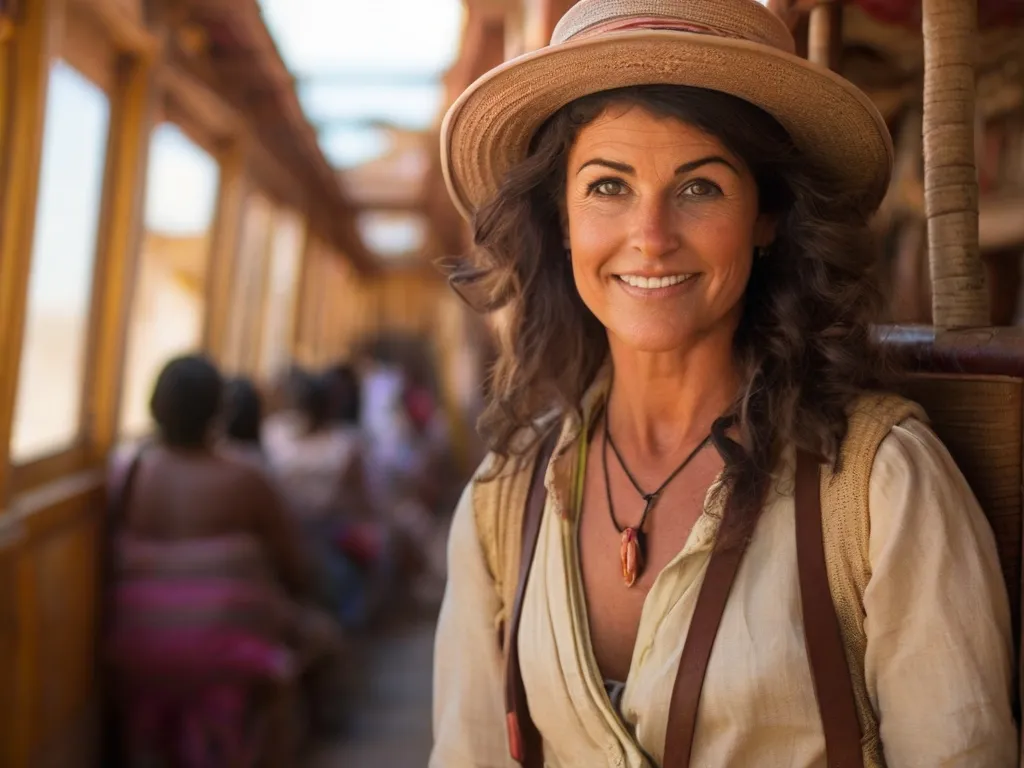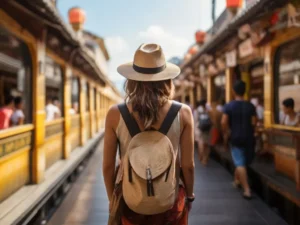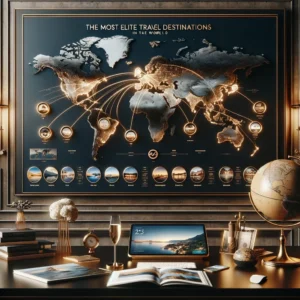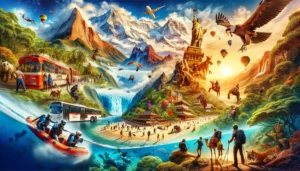Travel Photography Tips
Travel photography is a great way to capture your memories and share them with others. It can also be a fun and rewarding way to improve your photography skills. If you’re new to travel photography, or if you’re looking for ways to improve your skills, here are some tips to help you get started.
Composition Tips
One of the most important aspects of travel photography is composition. The way you frame your shot can make or break a photo. Here are a few composition tips to keep in mind:
- Use the rule of thirds.
- Include leading lines in your composition.
- Pay attention to the background.
- Experiment with different angles.
- Get close to your subject.
For more information on composition, check out our article on composition tips for photography.
Lighting Tips
Lighting is another important aspect of travel photography. The time of day, the weather, and the location can all affect the quality of your light. Here are a few lighting tips to keep in mind:
- Shoot during the golden hour.
- Use a tripod to avoid camera shake in low-light conditions.
- Experiment with different lighting modifiers.
- Use reflectors to bounce light back onto your subject.
- Use natural light whenever possible.
For more information on lighting, check out our article on lighting tips for photography.
Subject Matter Tips
When it comes to subject matter, the possibilities are endless. You can photograph anything from landscapes to street scenes to people. Here are a few subject matter tips to keep in mind:
- Look for interesting subjects.
- Be creative with your compositions.
- Don’t be afraid to experiment.
- Pay attention to the details.
- Tell a story with your photos.
For more information on subject matter, check out our article on subject matter tips for photography.
Equipment Tips
The right equipment can make a big difference in your travel photography. Here are a few equipment tips to keep in mind:
- Invest in a good camera and lens.
- Bring a tripod for low-light photography.
- Pack a variety of lenses to cover different situations.
- Use a polarizing filter to reduce glare.
- Bring a camera bag to protect your gear.
For more information on equipment, check out our article on gear tips for photography.
Post-Processing Tips
Post-processing is an important part of travel photography. It can help you to improve the quality of your photos and to create a more consistent look across your portfolio. Here are a few post-processing tips to keep in mind:
- Use a RAW editor to give yourself more control over your photos.
- Adjust the exposure, contrast, and white balance to improve the overall look of your photos.
- Use color correction tools to correct any color casts.
- Add noise reduction to reduce graininess.
- Sharpen your photos to improve the details.
For more information on post-processing, check out our article on post-processing tips for photography.
Travel photography is a great way to capture your memories and share
How to Take Better Travel Photos
Travel photography is a great way to capture your memories and share them with others. But taking great travel photos isn’t always easy. There are a lot of factors to consider, from the composition of your shot to the lighting and subject matter.
In this article, we’ll share some tips on how to take better travel photos. We’ll cover everything from choosing the right camera and lens to capturing stunning landscapes and street scenes. So whether you’re a seasoned photographer or you’re just getting started, read on for some helpful tips!
1. Choose the Right Camera and Lens
The first step to taking great travel photos is choosing the right camera and lens. If you’re new to photography, it’s a good idea to start with a mirrorless camera or a DSLR with a kit lens. These cameras are relatively affordable and easy to use, and they’ll give you a good range of shooting options.
Once you’ve gotten more comfortable with photography, you may want to consider investing in a more advanced camera and lens. A good travel lens will have a wide aperture, which will allow you to take photos in low-light conditions. It’s also important to choose a lens that’s versatile enough to handle a variety of shooting situations.
2. Consider the Composition of Your Shot
When you’re taking a photo, it’s important to think about the composition of your shot. The composition is the arrangement of the elements in your photo, and it can make a big difference in the overall impact of the image.
There are a few basic principles of composition that you can follow to improve your photos. First, try to keep your horizon level. This will help to create a sense of stability in your image. Second, pay attention to the rule of thirds. This rule states that you should divide your image into three equal parts, both horizontally and vertically. The most important elements of your photo should be placed along these lines or at the intersections of these lines.
Finally, experiment with different angles and perspectives. Don’t be afraid to get down low or get up high to get a different view of your subject.
3. Use Natural Light
Natural light is the best light for taking photos, so whenever possible, try to shoot outdoors during the day. The golden hour, which is the hour or so before sunset, is also a great time to take photos. The warm light at this time of day can create beautiful, soft images.
If you’re shooting indoors, try to find a window with natural light. You can also use a reflector to bounce light back onto your subject. Avoid using flash, as it can create harsh, unflattering shadows.
4. Focus on Subject Matter
When you’re taking a travel photo, it’s important to focus on your subject matter. What do you want to say with your photo? What story do you want to tell?
If you’re trying to capture a beautiful landscape, make sure that the main subject of your photo is the landscape itself. Don’t get too caught up in details, such as people or cars.
If you’re taking a photo of a person, make sure that the person is the main focus of the photo. Crop out any unnecessary background elements, and try to get a close-up of the person’s face.
5. Experiment with Different Techniques
There are a number of different techniques that you can use to take better travel photos. Here are a few ideas to get you started:
-
Use a tripod.
A tripod will help to stabilize your camera and prevent blurry photos. This is especially important if you’re shooting in low-light conditions.
Use a slow shutter speed.
A slow shutter speed can create a sense of movement in your photos. This is a great technique for capturing waterfalls, moving clouds, or cityscapes at night.
-
Use a wide aperture.
A wide aperture will allow you to blur the background of your photos, creating a more dramatic effect. This is a great technique for portraits or landscape photos.
Use filters.
Filters can be used to add creative effects to your photos. There are a variety of different filters available, so experiment with different ones until you find one that you like.
6. Post-Process Your Photos
Once you’ve taken your photos, you may want to post-process them to improve their quality. There are a number of different photo editing software programs available, such as Photoshop, Lightroom, and Capture
Composition is one of the most important aspects of travel photography. A well-composed photo can make a scene come to life, while a poorly composed photo can be boring and uninteresting.
There are a few basic principles of composition that can help you take better travel photos. These principles include:
-
Rule of thirds:
The rule of thirds is a compositional technique that divides the image into thirds, both horizontally and vertically. The most important elements of the photo should be placed along these lines or at their intersections.
-
Leading lines:
Leading lines are lines that lead the eye through the photo. They can be natural lines, such as a road or river, or man-made lines, such as a building or bridge.
-
Framing:
Framing is a technique that uses objects in the foreground to frame the subject of the photo. This can help to create a sense of depth and interest in the photo.
-
Symmetry:
Symmetry is a compositional technique that creates a sense of balance and order in the photo. This can be achieved by using symmetrical objects or by dividing the photo into two equal halves.
-
Asymmetry:
Asymmetry is a compositional technique that creates a sense of movement and energy in the photo. This can be achieved by using unbalanced objects or by placing the subject off-center.
In addition to these basic principles, there are a number of other compositional techniques that you can use to improve your travel photos. These techniques include:
-
Close-ups:
Close-ups can be a great way to capture the details of a scene or to isolate a particular subject.
-
Wide-angle shots:
Wide-angle shots can be used to capture a wide view of a scene or to create a sense of drama.
-
Long-exposure shots:
Long-exposure shots can be used to create a sense of movement or to capture the beauty of light.
-
Black-and-white photography:
Black-and-white photography can be a great way to create a timeless and dramatic image.
By experimenting with different compositional techniques, you can learn to take more interesting and visually appealing travel photos.
Here are some additional tips for taking better travel photos:
-
Take your time:
Don’t rush through taking photos. Take your time to frame the shot and to make sure that you are happy with the composition.
-
Experiment:
Don’t be afraid to experiment with different angles, lenses, and lighting conditions.
-
Get close:
Don’t be afraid to get close to your subject. This will help you to create more intimate and interesting photos.
-
Look for interesting light:
Look for interesting light conditions, such as early morning or late evening light.
-
Be creative:
Don’t be afraid to be creative with your photos. Try different things and see what works.
With a little practice, you can learn to take stunning travel photos that will capture the beauty of your travels and share them with the world.
Lighting is one of the most important elements of travel photography. It can make or break a photo, and it can be the difference between a good photo and a great one.
There are a few different things to consider when it comes to lighting for travel photography. First, you need to think about the time of day. The best time to take photos is usually early in the morning or late in the afternoon, when the light is soft and diffused.
You also need to think about the direction of the light. If you’re shooting during the day, you’ll want to position yourself so that the sun is behind you. This will help to create a more flattering light on your subject.
If you’re shooting at night, you’ll need to use artificial light. There are a few different ways to do this. You can use a flash, a headlamp, or a light stick.
When using artificial light, it’s important to be careful not to overexpose your photos. You can do this by using a low ISO setting and a fast shutter speed.
Here are a few tips for using lighting to improve your travel photos:
- Use natural light whenever possible.
- Position yourself so that the sun is behind you.
- Use a flash or other artificial light source to fill in shadows.
- Be careful not to overexpose your photos.
With a little practice, you can learn to use lighting to create stunning travel photos that will capture the beauty of your destination.
Travel photography is a great way to capture your memories and share them with others. It can also be a fun and rewarding way to explore new places and meet new people. If you’re new to travel photography, here are a few tips to help you get started:
-
Choose a camera that’s right for you.
There are many different types of cameras available, so it’s important to choose one that’s suited to your needs and budget. If you’re just starting out, a point-and-shoot camera or a mirrorless camera with a fixed lens is a good option.
-
Learn the basics of photography.
Even if you’re not a professional photographer, there are a few basic photography concepts that you should know. These include things like aperture, shutter speed, and ISO. There are many resources available online and in libraries to help you learn the basics of photography.
-
Explore your surroundings.
When you’re traveling, take some time to explore your surroundings and look for interesting things to photograph. This could include anything from landscapes to street scenes to people.
-
Don’t be afraid to experiment.
One of the best ways to improve your travel photography is to experiment with different techniques and styles. Try different compositions, different lenses, and different lighting conditions.
-
Share your photos.
Once you’ve taken some great photos, share them with your friends and family. You can post them on social media, print them out, or create a photo album.
With a little practice, you can take amazing travel photos that will capture your memories and inspire others.
Composition is one of the most important aspects of travel photography. When you’re composing a photo, you need to think about the overall balance of the image, the subject matter, and the lighting.
Here are a few composition tips to help you take better travel photos:
-
Use the rule of thirds.
The rule of thirds is a simple but effective composition technique that can help you create more balanced and visually appealing images. To use the rule of thirds, simply divide your image into thirds both horizontally and vertically. Then, place your main subject on one of the intersecting points.
-
Fill the frame.
When you’re shooting a close-up of a subject, try to fill the frame with your subject. This will help to create a more intimate and impactful image.
-
Use leading lines.
Leading lines are lines in the image that lead the viewer’s eye to the main subject. This can be anything from a road to a river to a person’s gaze.
-
Experiment with different perspectives.
Don’t be afraid to experiment with different perspectives when you’re taking photos. This could include shooting from a low angle, a high angle, or a bird’s-eye view.
-
Pay attention to the background.
The background of your image can be just as important as the foreground. Make sure that the background is not distracting and that it complements the main subject.
By following these composition tips, you can take better travel photos that will capture your memories and inspire others.
Lighting is another important aspect of travel photography. The type of lighting you use can significantly affect the mood and atmosphere of your images.
Here are a few lighting tips to help you take better travel photos:
-
Use natural light whenever possible.
Natural light is often the best light for travel photography. It’s soft, flattering, and can create beautiful shadows and highlights.
-
Shoot during the golden hour.
The golden hour is the time of day just after sunrise and just before sunset. The light during this time is warm and golden, and it’s perfect for taking photos.
-
Use a reflector to bounce light back onto your subject.
A reflector can help to fill in shadows and create a more even light.
-
Use a tripod to avoid camera shake.
When you’re shooting in low light
Equipment Tips for Travel Photography
When it comes to travel photography, there are a few essential pieces of equipment that you will need to have in order to take great photos. These include a camera, a lens, a tripod, and a memory card.
Camera
The type of camera that you choose will depend on your budget and your shooting style. If you are just starting out, a point-and-shoot camera can be a great option. These cameras are relatively inexpensive and easy to use, making them ideal for beginners.
If you are more serious about photography, you may want to consider investing in a DSLR or mirrorless camera. These cameras offer more features and flexibility than point-and-shoot cameras, making them a better choice for experienced photographers.
Lens
The lens that you choose will also depend on your shooting style. A wide-angle lens is a good option for capturing landscapes and cityscapes, while a telephoto lens is better for shooting wildlife and portraits.
If you are only planning on taking one lens with you on your trip, a versatile zoom lens is a good option. These lenses offer a range of focal lengths, making them ideal for shooting a variety of subjects.
Tripod
A tripod is a useful tool for taking sharp photos in low-light conditions. It can also be helpful for taking long exposures and panning shots.
If you are planning on doing a lot of night photography or taking long exposures, a tripod is a must-have.
Memory card
A memory card is essential for storing your photos. When choosing a memory card, make sure to choose one that has enough storage space for all of your photos.
You should also make sure to choose a memory card that is fast enough to keep up with your camera.
Other accessories
In addition to the essential pieces of equipment listed above, there are a few other accessories that you may want to consider taking with you on your trip. These include a camera bag, a cleaning kit, and a polarizing filter.
Camera bag
A camera bag is essential for protecting your gear while you are traveling. Make sure to choose a bag that is big enough to fit all of your equipment and that is comfortable to carry.
Cleaning kit
A cleaning kit is essential for keeping your camera and lenses clean. Make sure to include a lens brush, a cleaning cloth, and a sensor cleaning kit.
Polarizing filter
A polarizing filter can help to reduce glare and improve contrast in your photos. This can be especially helpful when shooting landscapes and cityscapes.
Conclusion
These are just a few of the essential pieces of equipment that you will need for travel photography. By following these tips, you can ensure that you have the gear you need to take great photos on your next trip.
Post-Processing Tips for Travel Photography
Post-processing is an essential part of travel photography. It can help you to improve the quality of your images, correct any mistakes that you made while shooting, and add your own personal style. In this article, we will discuss some of the best post-processing tips for travel photography.
1.
Use a RAW file format.
When shooting your photos, it is important to use a RAW file format. This will give you more flexibility when post-processing your images, as you will have more control over the color, exposure, and contrast.
2.
Develop a workflow.
Once you have your RAW files, it is important to develop a workflow for post-processing them. This will help you to save time and ensure that your images are consistent. Your workflow may vary depending on your specific needs, but it should typically include steps such as adjusting the exposure, contrast, and white balance; removing any unwanted noise; and cropping and resizing your images.
3.
Use editing software.
There are many different photo editing software programs available, each with its own set of features. Some of the most popular options include Adobe Photoshop, Lightroom, and Capture One. The best software for you will depend on your individual needs and preferences.
4.
Don’t be afraid to experiment.
When post-processing your images, don’t be afraid to experiment. Try different settings and techniques until you find a look that you like. The best way to learn is by practicing, so don’t be afraid to make mistakes.
5.
Share your photos.
Once you have post-processed your images, share them with the world! There are many different ways to share your photos, such as posting them on social media, submitting them to photo contests, or printing them into books or calendars.
By following these tips, you can improve the quality of your travel photos and create stunning images that will capture the beauty of your travels.
FAQ
- What is post-processing?
Post-processing is the process of editing and enhancing digital images after they have been taken. This can involve adjusting the exposure, contrast, color, and white balance; removing any unwanted noise; and cropping and resizing the image. - Why is post-processing important for travel photography?
Post-processing can help you to improve the quality of your travel photos, correct any mistakes that you made while shooting, and add your own personal style. It can also help you to create stunning images that will capture the beauty of your travels. - What are some of the best post-processing tips for travel photography?
Some of the best post-processing tips for travel photography include using a RAW file format, developing a workflow, using editing software, and experimenting with different settings and techniques. - What software is best for post-processing travel photos?
There are many different photo editing software programs available, each with its own set of features. Some of the most popular options include Adobe Photoshop, Lightroom, and Capture One. The best software for you will depend on your individual needs and preferences. - How can I share my travel photos?
There are many different ways to share your travel photos, such as posting them on social media, submitting them to photo contests, or printing them into books or calendars.
Sharing Your Travel Photos
Sharing your travel photos is a great way to share your experiences with friends and family, and to inspire others to travel. There are many different ways to share your travel photos, including social media, photo sharing websites, and printed photo books.
Here are some tips for sharing your travel photos:
- Choose the best photos. When choosing which photos to share, select ones that are well-composed, interesting, and visually appealing.
- Include a description. When sharing your photos on social media, be sure to include a description that tells your audience where you took the photo and what it is about.
- Use hashtags. When sharing your photos on social media, use relevant hashtags to help people find your photos.
- Share your photos on different platforms. Don’t just share your photos on one platform. Share them on multiple platforms, such as social media, photo sharing websites, and printed photo books.
Here are some specific tips for sharing your travel photos on social media:
- Use high-quality photos. Social media users are more likely to engage with your photos if they are high-quality.
- Post interesting photos. Social media users are more likely to engage with your photos if they are interesting and visually appealing.
- Include a call to action. When sharing your photos on social media, include a call to action, such as asking people to like or share your photos.
- Use hashtags. When sharing your photos on social media, use relevant hashtags to help people find your photos.
Here are some specific tips for sharing your travel photos on photo sharing websites:
- Choose a photo sharing website that is appropriate for your photos. There are many different photo sharing websites available, so choose one that is a good fit for your photos.
- Upload high-quality photos. Photo sharing websites are a great way to share your high-quality photos with others.
- Include a description. When uploading your photos to a photo sharing website, be sure to include a description that tells your audience where you took the photo and what it is about.
- Use tags. When uploading your photos to a photo sharing website, use relevant tags to help people find your photos.
Here are some specific tips for sharing your travel photos in printed photo books:
- Choose a photo book that is appropriate for your photos. There are many different types of photo books available, so choose one that is a good fit for your photos.
- Select high-quality photos. Printed photo books are a great way to share your high-quality photos with others.
- Include a description. When creating your photo book, be sure to include a description that tells your audience where you took the photos and what they are about.
- Add personal touches. Printed photo books are a great way to add personal touches to your photos. You can add captions, quotes, or other personal touches to your photos.
By following these tips, you can share your travel photos with friends, family, and the world.
Travel photography is a great way to capture your memories of your travels and share them with others. It can also be a fun and rewarding way to improve your photography skills.
If you’re new to travel photography, there are a few things you can do to get started.
-
Choose a camera that’s right for you.
There are many different types of cameras on the market, so it’s important to choose one that’s right for your needs and budget. If you’re just starting out, a point-and-shoot camera or a mirrorless camera with a fixed lens is a good option. If you’re more experienced, you might want to consider a DSLR camera with interchangeable lenses.
-
Learn the basics of photography.
Even if you’re not a professional photographer, there are a few basic photography concepts that you should know. These include things like aperture, shutter speed, and ISO. There are many resources available online and in books that can help you learn the basics of photography.
-
Explore your surroundings.
When you’re on vacation, take the time to explore your surroundings and find interesting things to photograph. This could include anything from famous landmarks to local street scenes. Be open to trying new things and don’t be afraid to experiment with different techniques.
-
Take lots of photos.
The more photos you take, the more likely you are to capture some great shots. Don’t be afraid to delete the bad photos later.
-
Share your photos.
Once you’ve taken some great photos, share them with others! You can post them on social media, print them out, or even create a photo book.
With a little practice, you can learn to take amazing travel photos that will capture your memories for years to come.
Resources for Travel Photography
Here are some resources that can help you learn more about travel photography:
- Lonely Planet’s Travel Photography Tips
- National Geographic’s Travel Photography Tips
- Britannica’s Travel Photography Article
- Photojojo’s Travel Photography Tutorials
- PetaPixel’s Travel Photography Articles
- What is post-processing?




